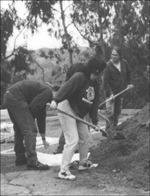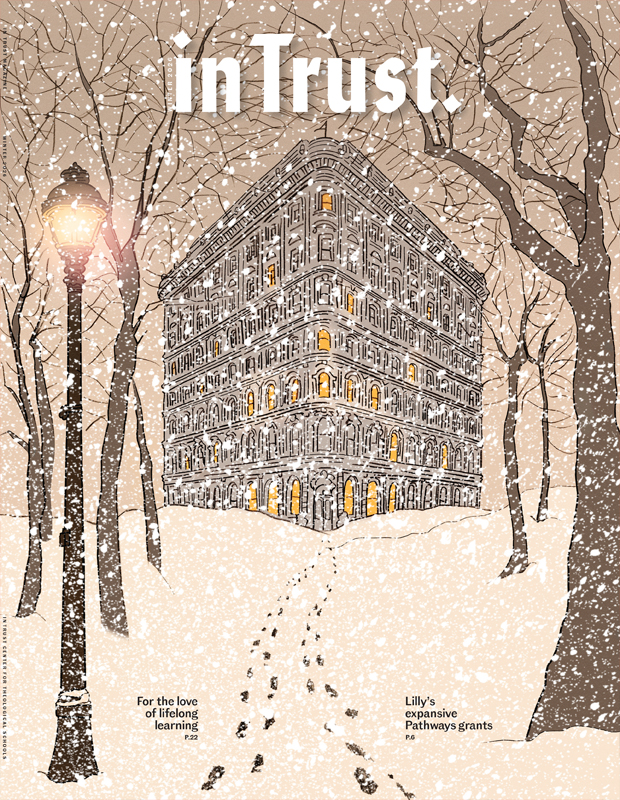(Note: due to the flexible nature of the World Wide Web, much of what was reported here has changed substantially.)
Your school probably has a presence on the World Wide Web: 254 of the 286 North American theological schools identified by Fuller Theological Seminary on its Web page do. Some Web sites consist of a short paragraph introducing the institution; others are hugely elaborate with maps of where graduates work, explorations of arcane theological controversies, and e-mail connections to students present and past. One offers sound clips of its choirs, another shows an animated sketch of the chasm between God and man (sic) being bridged by the cross.
Simple or complex, the success of a Web page depends for the most part on how well it represents its school, and how effectively it welcomes the reader into the community. Here are some noteworthy sites—and some warnings about pitfalls.
Of course your chapel—or your administrative center, or your oldest classroom building—is lovely and has deep emotional resonance for everyone connected with your school. It does not, however, mean much to someone who has seen several dozen such views on other theological school Web sites. There are exceptions—the Theological College of Queen’s University in Kingston, Ontario, for example, has a charming shot of students wandering amidst the trees in front of their very impressive stone building.

St. John’s plays the angles.
If you are convinced that your site needs a picture, make it stand out. St. Patrick’s Seminary in Menlo Park, California, has a pastel drawing of its main building, complete with palm trees (www.stpatricksseminary.org). St. John’s University School of Theology in Collegeville, Minnesota, has a home page featuring an interestingly angled photo of an interestingly angled building (www.csbsju.edu/sot/index.html). And given the ease with which images can be manipulated, it’s surprising that more schools haven’t stretched their imaginations and dared creativity and a bit of fun. Trinity Evangelical Divinity School has. The Deerfield, Illinois, school captured a view of its steeple in a salt shaker with the caption, “The world needs salt. Trinity assures its saltiness” (https://www.tiu.edu/divinity/). (That’s no fluke, either: Trinity’s distance education page has a photo of a number of plugs in a socket with the tag, “Extension options that are well grounded.”)
Photos don’t have to be of buildings, of course, although anonymous students reading or being perky don’t say much about a school either (except that it lacks originality, which is true enough in some cases). Composite photos can be pointless or helpful. Some schools post elaborate pastiches of books, flowers, musical scores that are pretty but say nothing. Wesley Theological Seminary, on the other hand, assembled a composite with a group of students with name tags (a clue about the makeup of the student body), a scene of worship in the school’s chapel (suggesting that this is a churchly institution) and a view of the United States Capitol that alludes to the school’s location in Washington, D.C. (www.wesleysem.edu).
You don’t need pictures; nice clean graphics make their own statement about your school. Atlantic School of Theology in Halifax, Nova Scotia (https://astheology.ns.ca/), and Aquinas Institute of Theology in St. Louis (www.op.org/aquinas/) both have bands of color on the left of their page and text on the right: the effects are different, but each gives a sense of the school’s character.
Who Are You?
A few words or a few pictures can put a human face on your site and help keep browsers interested as they sift through the standard information. The Lutheran Seminary Program in the Southwest answers five questions from “A Student’s Perspective.” The student author obviously loves the school, but is realistic enough to warn potential applicants about the tight housing market in Austin and the paucity of Lutheran theology courses. Student profiles at Baylor University’s George W. Truett Theological Seminary are a shade more sanitized, but give some clue to the Waco, Texas, school’s diversity (www.baylor.edu/~seminary). Episcopal Theological Seminary of the Southwest in Austin posts photos of student activities, from feeding the homeless to posing at a “retro prom” under the heading “reality check” (https://www.etss.edu/index.shtml).
In a sea of slickness, James D. Shine’s Web site about the Baptist Missionary Association Theological Seminary, in Jacksonville, Texas, is an island of unpretentiousness. Shine, the school’s professor of biblical studies, maintains the site in Geocities free addresses as a labor of love. The site features quirky graphics, a touching dedication to a recently deceased professor, and an online gospel tract along with the usual. If this were the school I was looking for, I’d know it from this Web site (https://www.bmats.edu/).
News
Not news: two schools, who shall be nameless here, still flaunt big banners trumpeting the arrival of their new deans— both of whom started work in 1996.

Seasoning the site with a dash of salt.
 |
| Pacific Lutheran after the mudslide: above, students cleaning up; below, ceiling hole made by a tree. |
 |
News: Pacific Lutheran Theological Seminary in Berkeley was hit by California’s mudslides in February. The school’s president, Timothy Lull, had a memo online within days (with tales of volumes of Luther’s works flying across his office due to the impact of a falling tree). Even more effective are the pictures posted of students sandbagging and of the branches of the aforementioned tree poking through Lull’s ceiling (www.plts.edu).
Connections
Every school should post e-mail addresses for administration, faculty, students, and trustees. Such directories seem to exist in that order of frequency, with the last two being most unusual. Princeton Theological Seminary goes a step further, offering e-mail addresses of alumni and alumnae to other graduates (www.ptsem.edu). Princeton also offers links to schools from which its faculty have degrees.
As for links to other sites, a favorite at the In Trust office is Fuller Theological Seminary’s list of links to North American theological schools—thoughtfully arranged alphabetically, geographically, and by denominational affiliation (www.fuller.edu/seminaries). Who do you want your publics to know about? Denominational and academic links are obvious choices: some schools even remember to set up a link to the Association of Theological Schools (www.ats.edu). Some links are at once highly connected to a particular school and of general interest. An example is the Dothan Publication Project (www.gcts.edu/dothan/), which, under the direction of Gordon-Conwell Theological Seminary chancellor (and In Trust board chair) Robert Cooley, is cataloguing and summarizing the findings of an archaeological dig.
Goodies
Some schools offer useful freebies on their Web pages. Well-planned ones will keep readers coming back. Luther Seminary in St. Paul (www.luthersem.edu) and Pacific Lutheran have posted a joint Lenten devotional online. Princeton also offers online Lenten material. Preachers can find exhaustive—not to say exhausting—sermon notes on the Old Testament courtesy of Concordia Theological Seminary, Fort Wayne, Indiana (www.ctsfw.edu), or entire sermons in audio format and ready for the listening at Gordon-Conwell. Luther Seminary continues to maintain its lively Bible Tutor. Originally designed for students preparing for exams in basic biblical proficiency, the Bible Tutor is now available for all who wish to test their familiarity with biblical people, places, dates, and general scriptural knowledge.

An experiment in electronic publishing: journal title page.
Publications
Many schools are putting their print publications on line. A few are experimenting with electronic publishing. The McMaster Journal of Theology and Ministry (https://www.mcmaster.ca/mjtm), a project of McMaster Divinity College in Hamilton, Ontario, publishes six articles in its first issue, “Prophets and Margins.” Although there is a response form at the end of each piece, none have yet been posted. Aquinas takes a different approach, posting papers by faculty and students on a variety of themes from “Holy Week in Milan: 385 C.E.” to “A Nineteenth Century Catholic Justification of Slavery.” Philadelphia’s Westminster Theological Seminary sponsors several ongoing discussion groups, including one on apologetics (www.wts.edu).
Once in a while, a school makes a simple addition to its Web site that just makes sense. Why not let it be known that your school has a place for those who wish to volunteer, like the Lutheran School of Theology at Chicago (www.lstc.edu)? Why not put information on your senior students online in hopes that it might help them find a position, as does McCormick Theological Seminary in Chicago (www.mccormick.edu)? And—here’s an obvious one—why not post a prayer for your school, like Nashotah House in Nashotah, Wisconsin (www.nashotah.edu)?
Labor of Love
It was “kind of an accident” that James D. Shine got involved with a Web site about Baptist Missionary Association Theological Seminary. The site was started by a foreign student at the school; when he headed home to Belarus, Shine took over its management.
The site is Shine’s, not the school’s, although the school’s administrators and trustees are enthusiastic supporters. Geocities (www.geocities.com) offers free Web site space, but only to individuals. What individuals put on their pages is up to them, within the limits of Geocities’ rules. Shine has gotten so caught up in the Web that he maintains three other sites—his own, one about his home church, and one about the Baptist Missionary Alliance chaplaincy committee. He is clearly given to learning by doing—his site is full of experimentation: animated graphics, music, plus links to Internet resources abound.
Shine appreciates the visitors who log into his guestbook, and points out that some prospective students have visited the school after visiting the site, and some have enrolled. Other visitors have been graduates of the school, members of the Baptist Missionary Association, and wanderers through the Web.
Touched by the Troubles
Though the site manager still hadn’t posted any publicly by mid-March, messages of concern began to arrive in the Pacific Lutheran Theological Seminary guestbook just days after the school was hit with mudslides in February: site visitors were moved by pictures the school’s president, Timothy Lull, had taken to document the damage for insurance companies and posted online as soon as they were in hand. Now donations are coming into the emergency repairs fund—also announced online. While it is impossible in most cases to document a direct connection between pictures and donations, Lull has referred potential donors to the Web site to get a sense of the extent of the work that needs to be done—about $100,000 in the next three months, perhaps twice that in the long run.
Gerald Jones, the PLTS site manager, is a second-year student at the school who describes himself as a “typical self-taught tech head.” His first interest is American church history, he says, but he concedes that his ability at Web site design has led him into a work-study assignment that is both lucrative and enjoyable. The school’s site is visited about forty times each day, he says, and the reports on storm damage are the most popular parts of the site.
PLTS’s site has a particularly human touch. When the campus maintenance director Frank Uchino’s wife Katherine died in January, campus pastor Paul Bodin suggested that Jones post the news, along with a picture of the couple. Within a week, a dozen people who knew the Uchinos had sent condolences. “If we were there, we would give you a big hug,” e-mailed one old friend.
Student Profiles
There’s no way to be sure how many of McCormick Theological Seminary’s seniors have found jobs through the student profiles posted on the Web, according to Mary Paik, the school’s vice president for student affairs, who put them there. But she knows that they are used, and in three ways. Some members of pastoral search committees check the Web for likely leads and happen upon McCormick’s profiles. Others already have a relationship with the school and head to the Web site intentionally. It’s a smart move, according to Paik, because the profiles are available online months before they can be had in hard copy. Still others have seen printed versions of the profiles, but visit the Web site for quick and easy access. McCormick is the only seminary of the Presbyterian Church (U.S.A.) that puts profiles of senior students online.


























